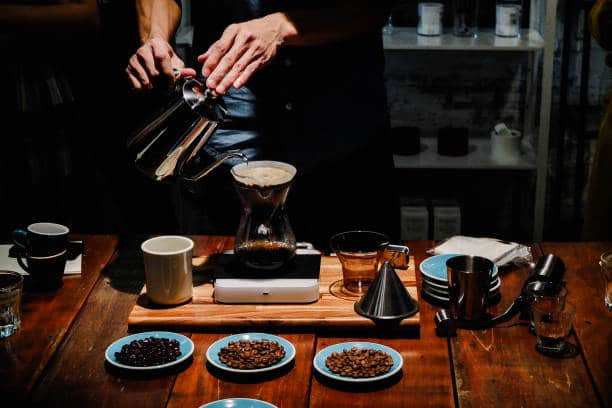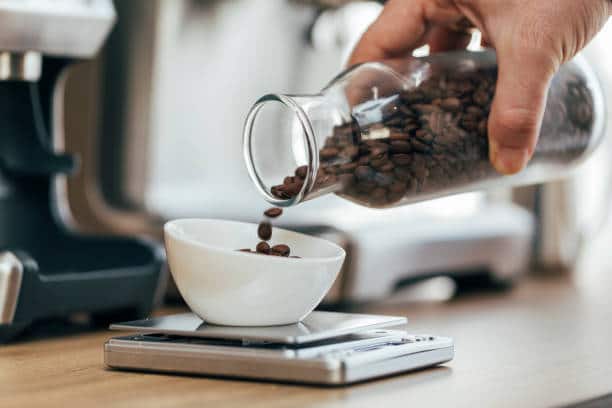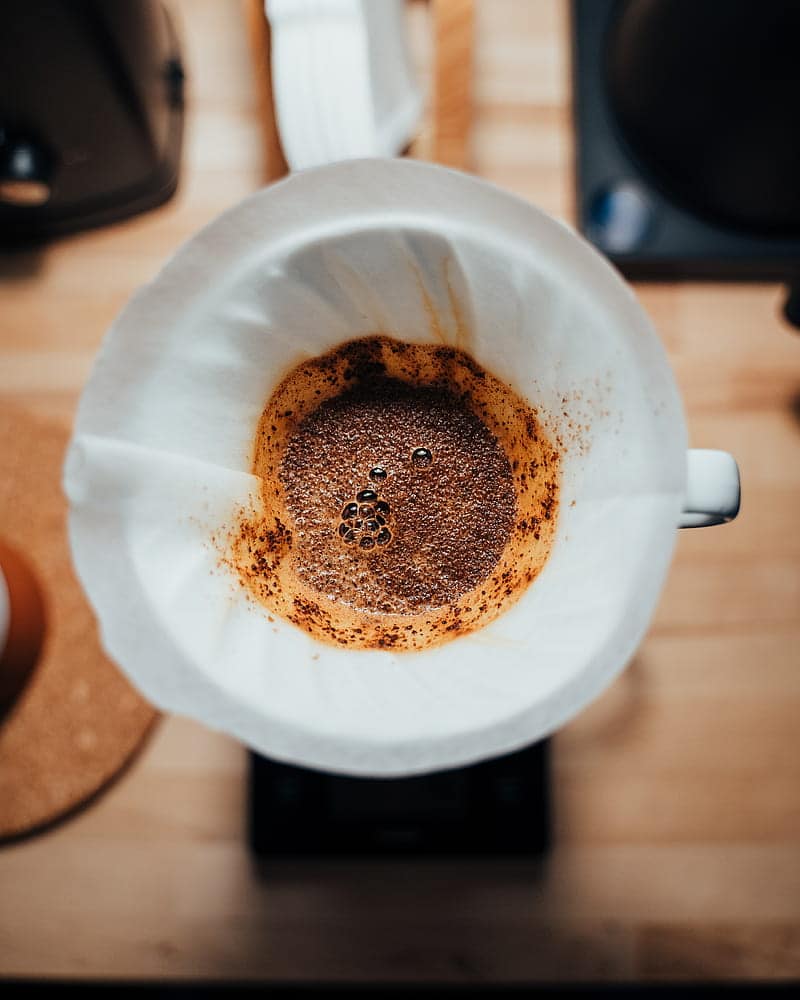Coffee is a beloved beverage that gets people through their mornings and energizes them throughout the day. However, many coffee drinkers struggle with measuring the right amount of coffee to make the perfect cup.
Table Of Contents
−- The importance of accurate coffee measurement
- Factors that affect coffee measurement variation
- Different ways to measure coffee
- How to calculate the coffee-to-water ratio for a single 8-ounce mug of coffee:
- Use a scale for the most precise results
- Using volumetric measurement – A tablespoon or scoop
- The standard measurement – 6 oz. fresh water to 2 Tbsp coffee
- Coffee-to-Water ratio typically done by weight
- Coffee-to-Water Ratio – 1:4 for those without a Scale
- The Importance of freshly ground coffee
- Conclusion
Whether you’re a seasoned barista or a beginner, learning how to properly measure your coffee can make all the difference in your brew’s taste and quality.

In this blog post, we’ll explore different ways to measure coffee and provide tips on getting the perfect ratio for a delicious cup every time. So grab your favorite mug and let’s dive in!
The importance of accurate coffee measurement
Accurately measuring coffee is crucial to getting a consistently great cup every time. As mentioned earlier, the “Golden Ratio” is a general guideline that suggests one to two tablespoons of coffee for every six ounces of water.
However, this ratio can be adjusted based on personal preference. That’s why it’s important to use a reliable and precise method, such as using a scale, to measure coffee for the most consistent results.
By doing so, you’ll always know exactly how much coffee you’re using and can easily adjust the ratio to suit your taste.
Factors that affect coffee measurement variation

It is common to read advice on how many tablespoons of coffee you should use to produce the best cup. However, you might now know how much coffee is in a pound. Unfortunately, because of many circumstances, it may not be feasible to determine precisely how many tablespoons of coffee there are in a pound.
Quantity per scoop
The amount of coffee that each person scoops vary. While some people scoop only a tiny quantity, others attempt to scoop as much as possible on a single tablespoon at a time. As a result, these two individuals consume the same pound of coffee over vastly different periods.
Coffee kind
While some can get just one bean in every tablespoon, others can collect as many as three beans in each tablespoon. The reason is that the quantity of tablespoons will vary depending on whether you’re using whole beans or ground.
As a result, finishing a pound of coffee may need more teaspoons for someone who consumes one coffee bean for every tablespoon than for someone who consumes three beans per tablespoon.
Tablespoon-sized measurement
Tablespoons come in a variety of shapes and sizes. As a result, it’s impossible to estimate the precise number of tablespoons needed to brew a pound of coffee.
If you have a little tablespoon, you will use up a pound of coffee more slowly than someone with a bigger one. 0.18oz to 0.35oz is the typical size of tablespoons.
According to these estimates, it will take anything from 45 to 90 tablespoons of ground coffee to use up a pound of the stuff, depending on the size of your tablespoon.
Tablespoons vs. pounds
When it comes to volume, tablespoons, and pounds are two different things. Measures such as tablespoons and pounds are distinct from one another. There is no direct translation between the two. The coarseness of the grind of the coffee is a crucial factor in a pounds-to-tablespoons conversion. More coffee grounds are produced per pound of coarsely ground coffee because coarsely ground coffee takes up more space than finely ground coffee of the same weight.
A couple of tablespoons per shot is what you’ll find in many recommendations on how to create the best cup of coffee. However, it is not clear how much coffee is in one tablespoon. Tablespoons aren’t used as a conventional unit of measure. The reason is that tablespoon sizes may vary. Aside from size differences, it may also vary in depth.
Different ways to measure coffee
Here are some common ways to measure coffee:
- Volume: This is a simple way to measure coffee using a measuring cup or spoon. One tablespoon of coffee grounds is typically used for every 6 ounces of water.
- Weight: Measuring coffee by weight is a more accurate way to ensure consistent coffee flavor. A digital kitchen scale can be used to measure coffee beans or grounds. A general rule of thumb is to use a ratio of 1:16, which means one gram of coffee for every 16 grams of water.
- Scoops: Using a coffee scoop is a popular way to measure coffee. A standard coffee scoop holds about 10 grams of coffee, which is roughly equivalent to two tablespoons.
- Eyeballing: Some people prefer to measure coffee by simply eyeballing the amount of coffee grounds they use. While this method may work for some people, it can be difficult to achieve consistent results.
- Coffee Maker: Some coffee makers come with built-in measuring tools to make measuring coffee easier. These tools can include a scoop or a fill line.
- Pre-packaged Portions: Pre-packaged coffee pods, capsules or sachets offer a convenient way to measure coffee. These portions are pre-measured and typically contain the right amount of coffee for one cup.
How to calculate the coffee-to-water ratio for a single 8-ounce mug of coffee:

| Measurement Type | Amount of Coffee Grounds | Amount of Water | Coffee-to-Water Ratio |
|---|---|---|---|
| Volume | 1 tablespoon | 8 ounces | 1:8 |
| Weight | 5 grams | 8 ounces | 1:16 |
| Scoops | 1 scoop (10 grams) | 8 ounces | 1:16 |
| Eyeballing | Varies | 8 ounces | Varies |
| Coffee Maker | Varies | 8 ounces | Varies |
| Pre-packaged Portions | 1 portion (varies) | 8 ounces | Varies |
Again, it’s important to note that these ratios are just general guidelines, and the actual ratio may vary depending on personal preference and other factors.
Ultimately, the best way to measure coffee depends on your personal preference and the type of coffee maker you are using. Experiment with different methods until you find the one that works best for you.
Use a scale for the most precise results
Using a scale is the most accurate way to measure coffee when brewing. As the previous section explained, measuring coffee by volume can lead to inconsistencies in taste and strength. A digital scale that measures in grams is the best choice for precise measurements.
This method ensures that the coffee-to-water ratio is exact, allowing for a consistent and enjoyable cup of coffee every time. While it may seem like an extra step, using a scale can make a significant difference in the quality of your coffee. Plus, with the ease of digital kitchen scales, it’s a simple addition to your brewing routine.
Using volumetric measurement – A tablespoon or scoop
Another way to measure coffee is through volumetric measurement using a tablespoon or scoop. While not as precise as using a scale, it can still provide accurate measurements.
A standard scoop usually measures 1 tablespoon, while a heaping scoop may measure up to 2 tablespoons. Using tablespoons or scoops, a typical cup of coffee contains 8 ounces of coffee. To measure enough coffee for 8 cups, you can use one cup of grinds and add 6 tablespoons or 1 cup and 3 scoops of coffee.
However, it is important to note that inaccuracy may occur when using this method, so it is still advisable to use a scale whenever possible.
The standard measurement – 6 oz. fresh water to 2 Tbsp coffee
As mentioned earlier, the standard measurement for coffee is 6 ounces of fresh water to 2 tablespoons of ground coffee. This ratio is called the “Golden Ratio” as it produces a perfect balance between the water and coffee flavor. It is recommended to stick to this measurement to achieve a perfect cup of coffee.
However, if you prefer a stronger or weaker brew, you can make adjustments accordingly while keeping the same ratio in mind. Remember that the quality of water and the freshness of the coffee beans also play a crucial role in the taste of your coffee, so make sure to use clean, fresh water and freshly ground coffee for optimal results.
Efficiently measuring your coffee is a vital aspect of your coffee-making process and can make a significant difference in the quality of your brew.
Coffee-to-Water ratio typically done by weight
When it comes to coffee measurement, using a scale can help achieve the most precise results. This is especially important when measuring coffee-to-water ratio, which is typically done by weight.
The recommended ratio for home brewing is 17:1, or about 10 grams of coffee for every 6 oz cup of water. By using a scale, coffee lovers can ensure that they are achieving this perfect ratio every time.
While volumetric measurements such as tablespoons or scoops can also be used, they may not be as accurate as weight measurements.
Volume measuring limitations
Volume measuring is not always practical or accurate due to several variations. For one, coffee beans come in various shapes and sizes. Moreover, in terms of cup size, a cup of coffee from Panama might vary greatly, while the same cup from Indonesia can be much more significant.
However, size isn’t the sole consideration; density is as well. For example, 4g of coffee may be all that is in a tablespoon of coffee. As much as 7 g of coffee can be found in a tablespoon of various coffee (and yet, the beans can even look the same size).
Coffee-to-Water Ratio – 1:4 for those without a Scale
For those without access to a scale, following a coffee-to-water ratio of 1:4 can help ensure a decent cup of coffee. This means using one part coffee to four parts water.
For example, for a standard 6 oz cup of coffee, use 1-2 tablespoons of ground coffee and add 4 times the amount of water (24 oz). While this method is not as precise as using a scale, it is a helpful guideline for those who want to measure their coffee without investing in equipment.
However, keep in mind that factors such as grind size and coffee freshness can also affect the taste of your coffee, so experiment and adjust accordingly.

The Importance of freshly ground coffee
Now that we have discussed the different methods of measuring coffee, let’s talk about the importance of using freshly ground coffee. Coffee beans start losing their flavor as soon as they are ground, so using previously ground coffee can result in a less satisfying cup of coffee.
For the best taste, it’s recommended to grind your coffee beans just before brewing. Additionally, using a quality grinder can ensure a consistent grind size, which is important for optimal extraction during the brewing process.
Remember, the quality of your coffee starts with the beans and how they are prepared, so always aim for the freshest and best quality possible.

Conclusion
To estimate how many cups of coffee you’ll get out of a given amount of whole beans or ground coffee, use the characteristics listed above as a guideline. Either way, the optimum coffee brewing results can be achieved by following the recipe’s average measurements.
While cups, coffee scoops, and teaspoons can all measure the volume of coffee, these are all volume-based metrics. This renders them useless. All of them are inaccurate.
The origin, variety, processing, and degree of a coffee roast can all significantly impact its weight, as we saw in the section above.
However, even while one scoop may be equal to one cup, we may be raising or reducing the amount of coffee we use by a quarter. This can have a significant impact and lead to too little or too many extractions. Not to mention that we won’t be able to replicate a fantastic cup if we don’t have scales. So that is why scales are a good investment.
Disclaimer: This post contains affiliate links, which means I may receive a small commission, at no extra cost to you, if you make a purchase using these links. Remember to support us by purchasing through the Amazon/Walmart/Impact Radius links provided. Last update on 2024-04-20 / Affiliate links / Images from Amazon Product Advertising API
Disclosure: No compensation or free products were received in exchange for writing this review.

Editorial Staff
The editorial staff at Crazy Coffee Crave is a team of coffee enthusiasts & Baristas who enjoy the one thing we all think about as soon as we get up in the morning. Trusted by thousands of readers worldwide.





